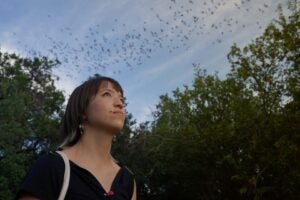AUSTIN, TexasA new, painless cervical cancer detection method that uses a small fiber optic probe instead of a surgical knife will be made available to 1,800 women through a new grant to The University of Texas at Austin and M.D. Anderson Cancer Center. The $8.9 million grant to finance the clinical trial comes from the National Institutes of Health.
The cancer-detecting laser probe was developed by Dr. Rebecca Richards-Kortum, a professor of electrical and computer engineering at UT Austin’s Department of Biomedical Engineering, and Dr. Michele Follen, a professor of gynecologic oncology at M.D. Anderson. Follen is leading the clinical trial to support U.S. Food and Drug Administration approval of the device. The probe is being made available to women in Houston.
The device is intended to replace the colposcopy, a test that is used as a follow-up to the long-standing cervical cancer detection procedure known as the Pap smear. The colposcopy is used when the Pap smear indicates the possibility of cervical cancer, the second most common cancer in women worldwide.
The probe is connected to a computer in the physician’s office that instantaneously reports the presence of pre-cancerous cells and requires no tissue removal or incision, Richards-Kortum said. She said use of the probe “doesn’t require the same amount of training and visual recognition skills required to do colposcopy.”
Richards-Kortum, whose findings are presented in more detail in Discovery Magazine,the UT Austin research and scholarship publication, said the procedure “narrows both the reporting time and the margin for error in the test. It reduces the false positive rate by 20 percent. We’ve estimated this technology could save up to $625 million annually in the United States.”
The laser probe uses fluorescence and reflectance spectroscopy and measures the wavelengths of light bounced off different surfaces. In simple terms, the laser probe works by shining light on the cervix and reporting what it sees. Cancer cells reflect light differently from the way healthy cells reflect light. The computer translates the light’s reflection into a report indicating whether the patient is healthy or has a problem.
“Cervical cancer is the second most common cancer in women worldwide,” said Richards-Kortum. “In the United States, over $6 billion is spent annually in the evaluation and treatment of low-grade precursor lesions. Resources are wasted on the evaluation and treatment of lesions not likely to progress to cancer. Both the screening and detection of cervical cancer could be vastly improved by technologies which improve, automate and decrease the cost of screening and detection.”
Follen said: “The treatment of cervical cancer could be vastly improved by technologies, which increase accuracy, automate results and decrease the costs of screening and detection. We are very excited about the project. It is one of the largest grants ever to go to UT and it got funded on round one. We should all be very proud of Dr. Richards-Kortum and her students.”
Two years ago, the laser technology was licensed to a small company known as Lifespex that is conducting human trials in Europe. A smaller clinical trial also will be taking place in British Columbia under the supervision of Dr. Calum MacAulay of Canada’s British Columbia Cancer Centre.
If these trials, to be conducted over the next three years, prove successful, Richards-Kortum plans to point her laser at other potential cancer sites. “The technology will have broad applications to other organ sites such as the oral cavity and lung, the digestive tract, the bladder and skin,” Richards-Kortum said
Dr. Urs Utzinger, a research associate in biomedical engineering at UT Austin, will work on fine-tuning the instrumentation during the course of the trials.
For more information, contact Dr. Rebecca Richards-Kortum at (512) 471-2104, Becky Rische at the College of Engineering (512) 471-7272 or the Office of Public Affairs at (512) 471-3151. “A high resolution scan of Richards-Kortum is available via e-mail by contacting marsha@opa.wwh.utexas.edu.



